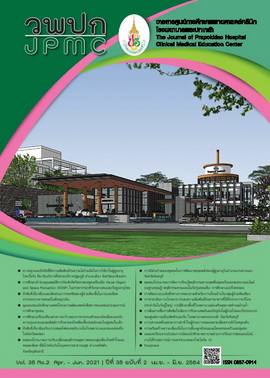การประเมินภาวะโภชนาการและความสัมพันธ์กับสารอาหารที่ได้รับจากการบริโภคประจำวันในวัยผู้ใหญ่: กรณีศึกษาพื้นที่โรงพยาบาลส่งเสริมสุขภาพตำบลบ้านถ้ำ
Main Article Content
บทคัดย่อ
ที่มาของปัญหา: ภาวะโภชนาการสะท้อนถึงการใช้ประโยชน์ของสารอาหารในร่างกาย การมีภาวะโภชนาการที่ดีและได้รับสารอาหารจากการบริโภคอาหารประจำวันอย่างเพียงพอ จะช่วยป้องกันและลดอุบัติการณ์การเกิดโรคไม่ติดต่อเรื้อรังได้
วัตถุประสงค์: เพื่อประเมินภาวะโภชนาการและหาความสัมพันธ์กับสารอาหารที่ได้รับจากการบริโภคประจำวันในวัยผู้ใหญ่ ที่อาศัยอยู่ในพื้นที่โรงพยาบาลส่งเสริมสุขภาพตำบลบ้านถ้ำ
วิธีการศึกษา: การศึกษาแบบตัดขวางระหว่างเดือนตุลาคม พ.ศ. 2560 ถึงเดือน กุมภาพันธ์ พ.ศ. 2561 ในผู้ใหญ่ อายุ 30 - 60 ปี จำนวน 120 คนที่อาศัยอยู่ในพื้นที่โรงพยาบาลส่งเสริมสุขภาพตำบลบ้านถ้ำ อำเภอดอกคำใต้ จังหวัดพะเยา งานวิจัยมีการเก็บข้อมูลการประเมินภาวะโภชนาการด้วยเครื่องวิเคราะห์องค์ประกอบร่างกาย และวิเคราะห์คุณค่าโภชนาการจากรายการอาหารบริโภคย้อนหลัง 24 ชั่วโมง จำนวน 2 วัน ด้วยโปรแกรมอินมูแคล รุ่น 3.0
ผลการศึกษา: ค่าสัมประสิทธิ์สหสัมพันธ์ของค่าไขมันในร่างกายและมวลกล้ามเนื้อสูงมากในเชิงลบ (r = -0.92) อย่างมีนัยสำคัญทางสถิติ (p < 0.05) ขณะที่ระดับไขมันในช่องท้อง มีความสัมพันธ์ระดับสูงมากในเชิงบวก (r = 0.90) กับค่าดัชนีมวลกายอย่างมีนัยสำคัญทางสถิติ (p < 0.05) สำหรับการบริโภคอาหารพบว่า ผู้เข้าร่วมวิจัยมากกว่าร้อยละ 80 ได้รับเส้นใยอาหาร แคลเซียม และธาตุเหล็ก น้อยกว่าปริมาณที่แนะนำต่อวัน ขณะที่ปริมาณโปรตีนจากอาหารมีความสัมพันธ์สูงมากในเชิงบวกกับวิตามินบีหนึ่ง (r = 0.98) วิตามินบีสอง (r = 0.89) ธาตุเหล็ก (r = 0.98) และโซเดียม (r = 0.95) อย่างมีนัยสำคัญทางสถิติ (p < 0.05)
สรุป: ผู้เข้าร่วมวิจัยที่มีภาวะน้ำหนักเกินและโรคอ้วน พบร่วมกับการมีมวลกล้ามเนื้อต่ำ และได้รับวิตามินและแร่ธาตุได้แก่ เส้นใยอาหาร แคลเซียม และธาตุเหล็ก น้อยกว่าคำแนะนำ แต่พบความสัมพันธ์สูงระหว่างโซเดียมและปริมาณโปรตีนในทิศทางเชิงบวก ซึ่งอาจแสดงถึงการบริโภคเนื้อสัตว์ที่มีส่วนผสมของโซเดียมสูง หากบริโภคอาหารในรูปแบบดังกล่าวเป็นเวลานานอาจทำให้มีความเสี่ยงสูงต่อการเกิดโรคไม่ติดต่อเรื้อรังในอนาคตได้ อย่างไรก็ตามควรมีการเฝ้าระวังและให้คำแนะนำในการบริโภคอาหารเพื่อสุขภาพและมีวิตามินและแร่ธาตุเป็นไปตามปริมาณที่แนะนำต่อวัน เพื่อเป็นการป้องกันปัญหาสุขภาพที่จะตามมา
Article Details
เอกสารอ้างอิง
Branca F, Lartey A, Oenema S, Aguayo V, Stordalen GA, Richardson R, et al. Transforming the food system to fight non-communicable diseases.BMJ [Internet].2019 [cited 2020 Oct 1];364:I296. Available form: https://www.ncbi.nlm.nih.gov/pmc/articles/PMC6349221/
Romieu I, Dossus L, Barquera S, Blottière HM, Franks PW, Gunter M, et al. Energy balance and obesity: what are the main drivers?. Cancer Causes Control 2017;28:247-58.
Institute for Population and Social Research, Mahidol University. Thai Health 2014: Self-management communities: foundation of national reform [internet]. Bangkok: Amarin Printing and Publishing;2014 [cited 2020 Oct 1]. Available from: https://www.hiso.or.th/hiso/picture/reportHealth/report/ThaiHealth2014Eng.pdf
Thomas-Valdés S, Tostes MDGV, Anunciação PC, da Silva BP, Sant'Ana HMP. Association between vitamin deficiency and metabolic disorders related to obesity. Crit Rev Food Sci Nutr 2017;57 (15):3332-43.
Phayao Provincial Offices. Summary report of Phayao province of annual budget 2016 [internet]. 2016 [cited 2020 Oct 1]. Available from http://www.phayao.go.th/pyoinfo7.pdf
Department of Health, Ministry of Public Health. Dietary reference intake for Thais [internet]. 2020 [cited 2020 Oct 7]. Available from http://nutrition.anamai.moph.go.th/images/dri2563.pdf
Ou YC, Chuang HH, Li WC, Tzeng IS, Chen JY. Gender difference in theassociation between lower muscle mass and metabolic syndrome independent ofinsulin resistance in a middle-aged and elderly Taiwanese population. Arch GerontolGeriatr 2017;72:12-8.
Thai National Health Examination Survey office. 4th Survey on food consumption of Thai, 2008-2009 [internet]. 2011 [cited 2020 Oct 10]. Available from: https://www.hiso.or.th/hiso/picture/reportHealth/report/report7.pdf
Ngeanpat N, Singhan C, Phanthurat N, Chanwigrai Y, Thassanasuwan N, Jaikhor P. Promoting utilization of herbs and indigenous vegetables to prevent chronic diseases in community of Ban Tam, Dokkhamtai district, Phayao province [dissertation]. Phayao: University of Phayao; 2017.
Ministry of Public Health. Thai health master plan 2018-2020. Nonthaburi : Thai Health Promotion Foundation; 2017.
Vasuthada C., Jaikla N., Prakongsri C., Theamngoen S. The development of a self-managementsupport model for non-communicable disease prevention among people at risk of chronic illness: Bangkaja, Muang District, Chanthaburi Province. J PrapokklaoHosp Clin Med Educat Center 2019; 36:142-53.
Rongmuang D. Applying Health Promotion Theories for behavioral modification to prevent and control obesity. J PrapokklaoHosp Clin Med Educat Center 2018;35:77-91.
Maleevong K., Saiwongse N., Sinawat S., Teamcharoen P. Survey of sodium chloride (Nacl) consumption among Thai population. Thailand Journal of Health Promotion and Environment Health2013; 36(4):118-28.
McKay J, Ho S, Jane M, Pal S. Overweight & obese Australian adultsandmicronutrient deficiency. BMC Nutr[Internet].2020 [cited 2020 Oct 1];1;6:12.Available form: https://www.ncbi.nlm.nih.gov/pmc/articles/PMC7193396/pdf/40795_2020_Article_336.pdf
Poli VFS, Sanches RB, Moraes ADS, Fidalgo JPN, Nascimento MA, Bresciani P, et al. The excessive caloricintake and micronutrient deficiencies related to obesity after a long-term interdisciplinary therapy. Nutrition 2017;38:113-9.

